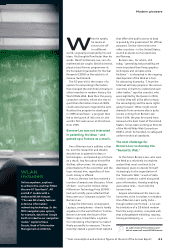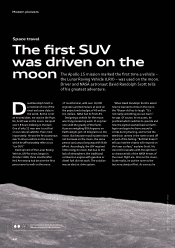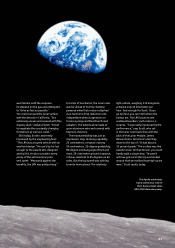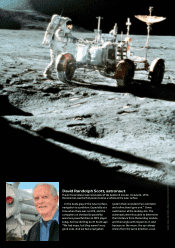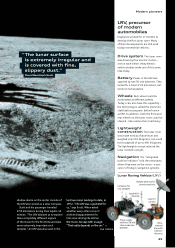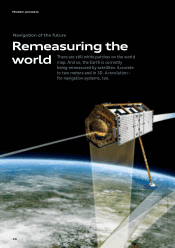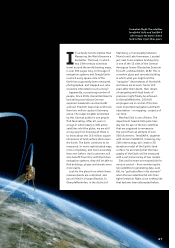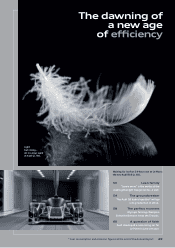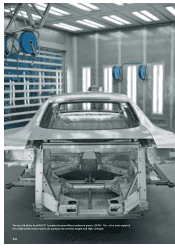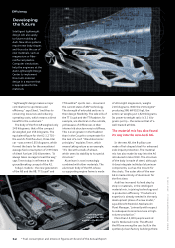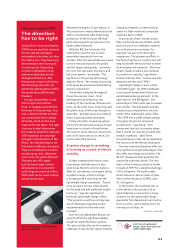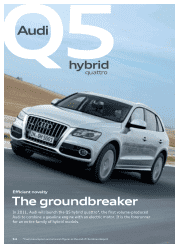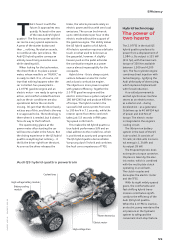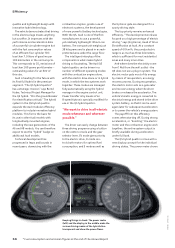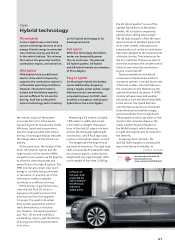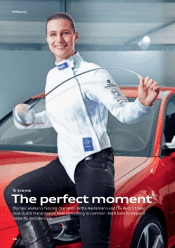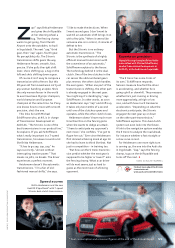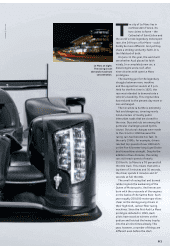Audi 2010 Annual Report Download - page 53
Download and view the complete annual report
Please find page 53 of the 2010 Audi annual report below. You can navigate through the pages in the report by either clicking on the pages listed below, or by using the keyword search tool below to find specific information within the annual report.
Effi ciency
Lean family
Lightweight design
Lightweight design is one of Audi’s great strengths. This core
competence of the brand is being systematically expanded
at the Audi Lightweight Design Center in Neckarsulm.
51
T
he motivation has to be
right,” says Heinrich Timm,
who for many years was
Head of the Audi Lightweight
Design Center in Neckarsulm. Even
when meeting Timm and his successor
Dr. Lutz-Eike Elend for the fi rst time
it is clear that they have the right
motivation. Elend, who holds a PhD
in production engineering, took over
from Timm in November 2010 and
is continuing the successful work of
decades past that made Audi one of
the leading brands internationally with
regard to lightweight design.
Heinrich Timm, a pioneer of light-
weight design, is retiring, but only
partially. He will continue to share his
valuable experience with the Company
as a consultant. The Audi Space Frame
(ASF) technology was developed under
his leadership in the mid-1990s,
sparking many new developments in
the fi eld of lightweight design.
The motivation in Neckarsulm is
also right in another regard. After Audi
established a special Aluminum Center
for development, production planning
and quality assurance here in 1994,
lightweight design was systematically
expanded into one of the brand’s core
competences. This is due primarily to
the fact that a very diverse range of
expertise is pooled at the site. “Our
work involves the entire process chain,”
explains Timm.
Lightweight design starts with
suitable materials, the development
of new, higher-performance alloys and
materials, continues through structural
design, computation, materials
technology and production planning to
quality assurance. Specialists in each
of these fi elds work under one roof
in Neckarsulm.
Lightweight design is a strategic
task for Audi; after all, comfort,
performance and safety requirements
bring with them an increasing amount
of weight. “One of our most enduring
aims for the future is to reverse the
weight spiral,” says Michael Dick,
Member of the Board of Management
for Technical Development at AUDI AG.
The reversal of the weight spiral
harbors signifi cant secondary eff ects.
By its very nature, there is a particularly
large amount of potential to be found
in the body. Compared to steel, an
ASF body is at least 40 percent lighter.
But the powertrain, the chassis, the
electrical systems and the interior
can also make major contributions to
weight reduction.
Every 100 kilograms saved reduces
fuel consumption by around 0.3 liters
per 100 kilometers, corresponding
to a reduction in CO2 emissions of
roughly 8 grams per kilometer.
Audi has incorporated a large number
of groundbreaking innovations in light-
weight design into production models
over the last quarter of a century.
The Company had already defi ned
automotive lightweight design as a
strategic project back in 1982. Many
technological milestones and a multi-
tude of patents came along the way
to the development of an entirely new
body structure, the Audi Space Frame.
The mission was nothing more and
nothing less than to once again reinvent
the self-supporting body, but this
time with aluminum, a material that is
substantially lighter than conventional
steel, and with a new principle.
In 1994, the Audi A8 became the
fi rst series production car to use the
Audi Space Frame, and the design
principle behind it remains valid to this
day: Diecastings and extruded sections
form a framework-like skeleton that
incorporates aluminum panels as co-
supporting elements. The components
with their various cross-sections and
shapes combine optimal function with
low weight.
Over 600,000 units of the Audi A2,
TT Coupé* and TT Roadster*, A8
and R8 have been built to date using
Audi Space Frame technology.
Audi has incorporated a large
number of groundbreaking
innovations in lightweight
design into production models.
Expertise under one roof (from left): Dr. Lutz-Eike Elend (Head of the Audi Lightweight
Design Center), Heinrich Timm (former Head of the Audi Lightweight Design Center) and
Albrecht Reimold (Neckarsulm Plant Manager).
* Fuel consumption and emission fi gures at the end of the Annual Report
PHOTOS | LAURENT BURST/AGENTUR FOCUS


